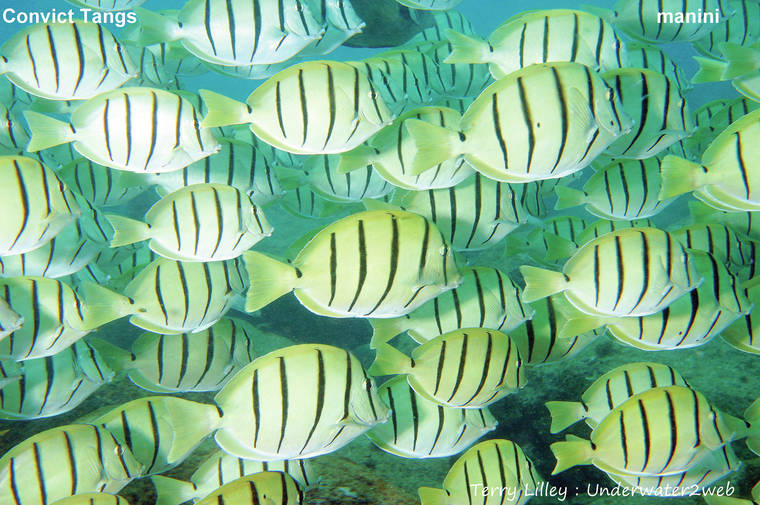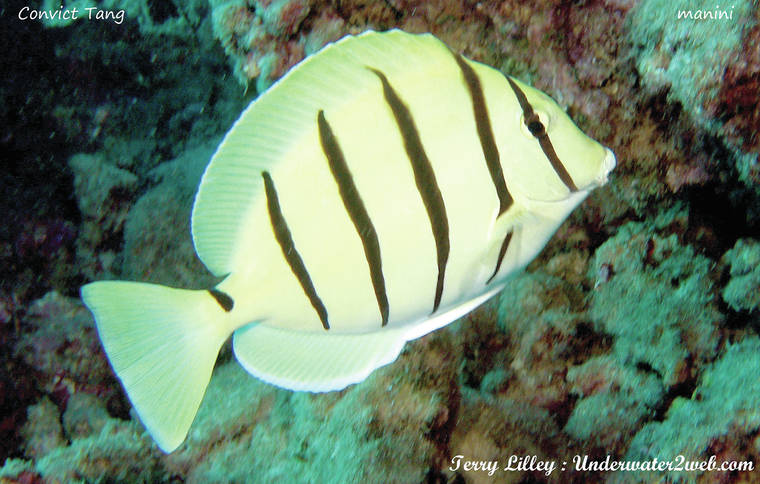While diving or snorkeling in Hawaii you will more then likely see manini the convict tang. Sometimes you can see this fish all by itself, feeding on algae that grows on the lava rocks, or you may be surrounded by a school of over 200 convict tangs. This fish is the most common surgeonfish in Hawaii and a tang is a type of surgeonfish because it has a sharp spike at the base of the tail that will give a diver or predator a deep cut if they get too close.
While diving or snorkeling in Hawai‘i you will more then likely see manini the convict tang. Sometimes you can see this fish all by itself, feeding on algae that grows on the lava rocks, or you may be surrounded by a school of over 200 convict tangs. This fish is the most common surgeonfish in Hawai‘i and a tang is a type of surgeonfish because it has a sharp spike at the base of the tail that will give a diver or predator a deep cut if they get too close.
Manini is a super important fish to keep our coral reefs healthy. Algae grows on the lava rocks and competes with coral growth. The large schools of manini flow with the shallow water waves over the coral reef, grazing on algae, which gives room for the corals to grow. They won’t over eat the algae in any one spot because the waves move them around so they only feed in one spot for a few seconds before drifting with the surge to a different part of the reef.
The reason the manini form large schools is because small, algae-feeding fish like the gregory protect their small territory on the reef from other algae-eaters, and they will aggressively chase away a single feeding convict tang. But when a giant school of 200 fish comes by they are overwhelmed and allow the school to feed briefly on their turf. The balance between the manini schools, single, aggressive gregory fish and the constant moving surf keep the reef free from too much algae growth, but does not allow the algae-eating fish to over eat the algae, as it is important food for many fish species.
Manini were an important food fish for the Native Hawaiian, and reportedly the fish was named for a Spanish adviser to King Kamehameha 1 whose name was Don Francisco de Paula y Marin. The Spanish name Marin was pronounced “manini” in Hawaiian!
One fascinating observation about the movements of a large school of manini I have observed is they all move about the reef at the same time. By using slow-motion, 4K video you can see that the fish in the school move as if they were a single organism, much like the cells of our body can all move at the same time when we run. The fish seem to inner connect and move as if they were one living creature. When the manini are ready to sleep at night they swim off by themselves away from the school and sleep in cracks in the reef then reform their school the next morning.
You can see manini in action in the movie “The World’s Guide to Hawaiian Reef Fish” on the underwater educational web page at underwater2web.com, and also have kids come swim with the manini in person in a marine science Reef Kids Camp with a nonprofit at reefguardianshawaii.org. Feel free to follow the marine science educational post on Instagram at terry.lilley
Aloha from under the surf.
•••
Terry Lilley, a marine biologist, lives in Hanalei. His websites include underwater-2web.com and gofundme.com/5urrm4zw.




